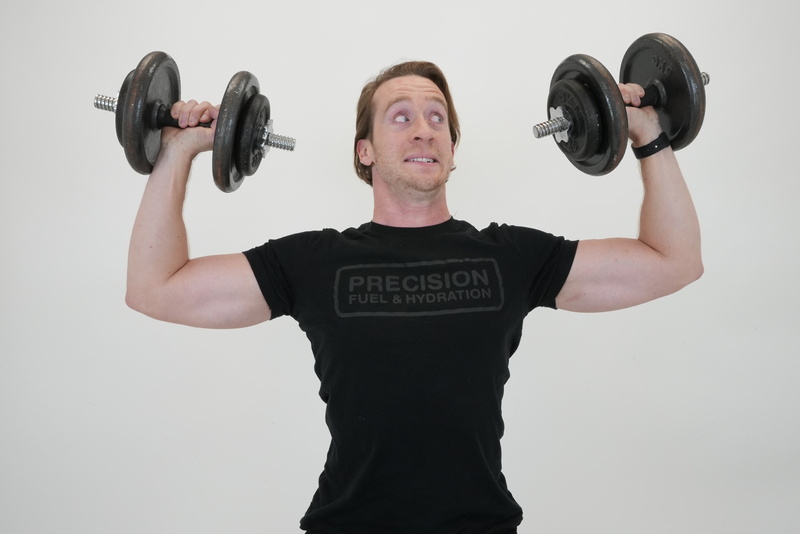Strength training has to be one of the most misunderstood areas of sport. Part of the reason for this is the nature and meaning of it can be so broad and diverse. It’s also not helped that ‘strength work’ is often seen as synonymous with ‘the gym’, ‘doing weights’ or ‘big muscles’.
I’ve been doing resistance work of some description or another for nigh on 30 years. I was a pretty scrawny looking kid in my teens who was low on self-confidence and high on 80’s action films, so I attempted to overcompensate by heading over to my university gym and shunting some steel.
However, so much of what I was did was grounded in vanity rather than in that of performance or wellbeing. It also saw the typically flawed approach of only training what I could see (chest and arms) and you had a better chance of seeing a pink unicorn than me seeing a ‘legs day’. After four years of doing that, I began to fill out a dayglow coloured tight t-shirt quite nicely.
The harsh reality was that it was a house built on sand because I was a functional car crash and had a perpetually weak back that would have its moments of collapsing like origami in the rain. Then later on as a triathlete, I was carrying far too much of the wrong muscle in all of the wrong places. In the end, I then made things even worse by stopping resistance training entirely as a panicked means of dropping my body mass.
The number of my mistakes I’m cataloguing here is pretty extensive. Then came my late forties, a plateau in my cycling performances and valid concerns over what kind of quality of life I want to have when I’m 75.

Luckily, I’m open-minded enough as a scientist to be open to change and that’s why strength work is back on the menu. The gains of doing such work may be possibly well-known to you. Reading the wider fitness press and it will tell you that such benefits include: enhanced performance, injury prevention, improved power and explosiveness, endurance enhancement, muscle imbalance correction, bone health and an increased metabolic rate.
The benefits
But, what does the scientific evidence tell us? Insofar as strength work for endurance athletes goes, there's broad support of its advantages. A 2014 review paper considered 26 viable studies on the subject and proposed that doing such work improved time-trial performance, exercise economy, VO2 max and muscle power in a range of well-trained endurance athletes. It's worth noting that this did depend on the type of strength work performed, the length of time it was conducted for and the current strength level of the athlete.
In terms of specific sport application, it’s also worth being aware then that in subsequent reviews, strength work improved running economy, short distance time trial performance and anaerobic speed qualities in distance runners, short and middle distance performance in swimmers, and in time trial and sprinting prowess in cycling. It’s also shown to be beneficial to both men and women too.
Whilst the evidence hasn't always been unequivocal, given the number of studies that broadly support its effectiveness, it’s certainly worthy of your consideration. However, as I mentioned, the other reason I wanted to do it was due to the increases in bone density, functionality and ultimately quality of life as I now begin to suffer the effects of ageing (i.e. the well reported reduction in lean muscle mass and mobility). The exercise choices I make at 48 need to be different to those I made at 18.

The initial phases of gaining strength can also be somewhat enjoyable. For example, my leg presses only started at a level that the cat next door could probably lift. However, within 5 months I had built this up progressively to over 300kg. My deadlifting – once something that I would avoid (but would keep my chiropractor on speed dial for), has become a cornerstone of my workouts. My philosophy is everything I now do is intended to help my cycling and crucially to help shore me up as a human machine. No more, no less and no more bicep curls. That’s a pretty big shift from Bryce of a 1993 vintage.
But what actual benefits have I found so far? Notably, some niggles and old injuries have gone and I finally feel functionally connected whether I’m lifting a hex bar (another recommendation) or carrying in the shopping. My son continues to lose at wrestling on the floor, so the perceived superhuman strengths that our children think their parents have remains untarnished for now.
As far as my sport goes, I haven’t had a real chance to see how it translates to my racing yet as we’re still in the depths of winter. I have found however, that I have developed an increase in the power I can produce at the end of races that I’ve done on online apps like Zwift. I’m hitting levels of sprinting at the end of races that I haven’t seen in at least five years. I’m also seeing power increases in the 1-2 minute ranges that I haven’t achieved since I was training specifically for track cycling over 10 years ago. Some of this may be due to the reported proportional muscle fibre changes resulting from strength work.
The challenges
There are some challenges to doing such work though. Arguably the main one is finding the time. If you’re already training once or even twice a day, something likely has to give to fit this in. In my own case, I’ve ensured that I do it on my way in to work and only on easier training days. This way, it doesn’t get skipped and it uses some of that dead time in the morning that used to see me staring at a cereal box or the internet.
I’m also economical on what I’m doing. I do five or six exercises max – mainly the big compound or functional moves of squats, deadlifts - and I get in and out as quickly as recovery between sets allows. I used to be concerned that society would collapse into a black hole if I didn’t check my emails for 40 minutes. It really doesn’t.
The second problem is that of a potential increase in fatigue. Strength work, like any form of training, should be progressive and carefully positioned around the other training you’re doing, but still, you’re going to get sore and tired from time to time. So, it requires thoughtful planning.
To close out here, a friend of mine recently gave me some great advice that I have found very useful. His quote was “you can’t ever be too strong, but you can be strong enough”. This kind of work can really help you, but don’t let your ego go wild or go down the rabbit hole chasing after it as a goal in itself.
